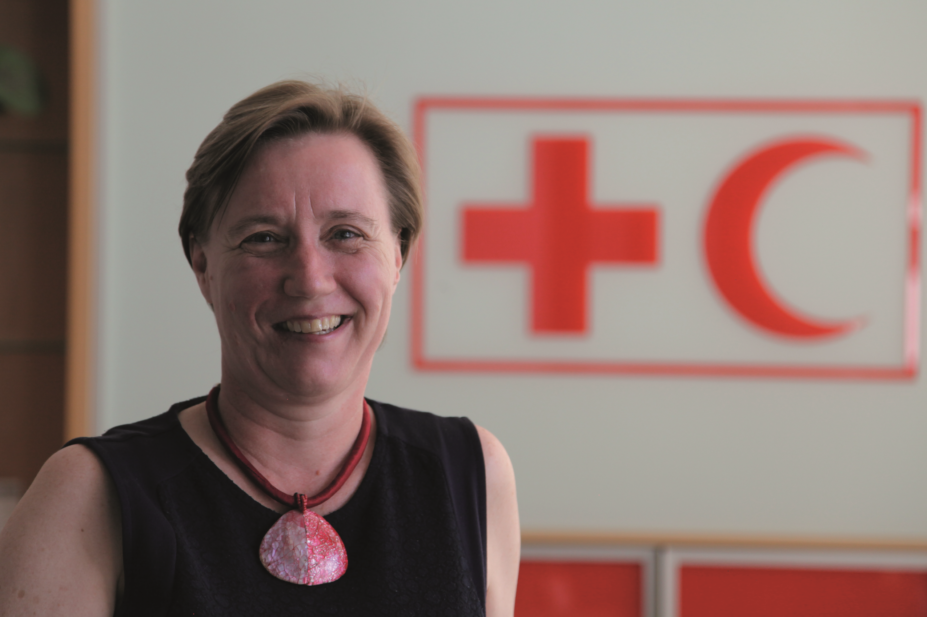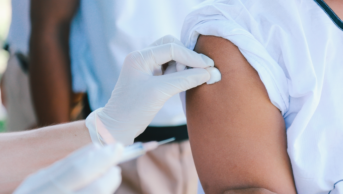
Courtesy of the International Federation of Red Cross and Red Crescent Societies (IFRC)
Julie Hall (MBE) from the International Federation of Red Cross and Red Crescent Societies (IFRC) discusses a new global health initiative that seeks to reduce cholera deaths by 90% in 47 countries affected by the disease, and eliminate transmissions in 20 countries by 2030. The World Health Organization (WHO) estimates that about 1.3 billion people are at risk of cholera in endemic countries, and that annually there are 2.9 million cases and about 95,000 deaths worldwide. The current outbreak in war-torn Yemen has infected nearly 908,702 people and resulted in 2,194 deaths. Outbreaks of the illness have also been reported this year in many other countries including Nigeria, South Sudan, Somalia and Haiti, with more than 1 million cases and more than 10,000 deaths reported, since the outbreak began on the island in October 2010.
Dr Hall, a public health physician from the United Kingdom, has, since September 2015, been IFRC director of health and care, and is also the IFRC representative on the WHO-led, Global Task Force on Cholera Control (GTFCC) — a network of cholera experts which brings together governments, non-governmental organisations, UN agencies, and scientific institutions. Before joining IFRC, she served as the WHO representative in the Philippines. Other career posts have included principal medical advisor to the Australian government (2006–2008) and team leader at WHO for emerging infectious diseases.
The Global Task Force for Cholera Control recently launched an ambitious ‘Ending Cholera by 2030’ road map. What are the key goals and strategies of this task?
Cholera causes thousands of deaths every year and many thousands of people become ill with the disease. It is very debilitating, and has a huge economic development impact as well as, obviously, a huge health impact. There is no reason why we should be seeing cholera in today’s day and age. We have the tools to control it and eliminate cholera spreading from one human to the next. We need a very strong exit plan to be able to do that. We need multiple partners to be involved and that is why we put together the global road map to end cholera by 2030. We know that water and sanitation — good quality water, good quality sanitation — make an enormous difference in stopping the spread of cholera from one human to the next. We also know that rapid treatment can reduce the death rate significantly, and very excitingly, we also now have a vaccine that is effective and safe and can be used in areas to prevent outbreaks as well as part of our outbreak control strategies. If we put all of those together and then we do one extra thing, and that is focus our attention on the hotspots, where cholera is endemic … we believe that we could eliminate cholera by 2030.
The road map also aims to reduce cholera deaths by 90% by 2030 and to eliminate transmission in 20 of the 47 countries affected by cholera. Is this achievable?
Definitely. Certainly on paper it’s very achievable, and when I say on paper, I mean, we have those tools. We know that water, sanitation and hygiene (WASH) work, we know it’s worked in developed countries. We simply don’t see cholera in developed countries any more. In addition to WASH, we also now have vaccines. We should be able to bring those elements together and really focus on the areas where cholera is endemic, and where the outbreaks are occurring. And the reason why we are saying we really want to focus on 20 hotspots is because those are the areas where cholera is causing the most damage — but they are also where a lot of the cholera elsewhere in the world is originating. But those hotspot areas are the places where we know infrastructure is the poorest, where economically people are the poorest, and where the job is hardest. Yet we know that it is in those hard-to-reach areas that we will get the greatest success.
What is the latest in the global oral cholera vaccines stockpile, and what are the prospects of expanding the production and availability of the vaccines?
Obviously the amount of vaccines in the stockpile changes all the time, depending on need. We are seeing huge cholera needs around the world at the moment, there has been significant increase in production capacity and this is very welcome. (According to the Global Task Force on Cholera Control, most of the oral cholera vaccine (OCV) doses produced since 2013 have entered the stockpile, which has expanded from from 2 million per year in 2013–2014 to seven million in 2016; 17 million doses are anticipated for 2017 and more than 25 million from 2018 onwards. Overall, global demand for OCVs is forecast at 44 million, 59 million and 76 million doses for 2018, 2019 and 2020, respectively.)
We obviously need to continue to work with manufacturers to be able to ensure all needs are met into the future. And we are excited about the possibility of further expansion of that capacity. (There are three WHO pre-qualified oral cholera vaccines, two of them available through the stockpile (Shanchol, licensed in India and manufactured by Shantha Biotechnics, a subsidiary of Sanofi; and Euvichol, licensed in South Korea and manufactured by EuBiologics).
In addition, the lead time to production has reduced, and we are now seeing some very exciting developments in the potential for the vaccines to be very small light plastic vials, which will reduce shipping costs. According to WHO, the current cost is US$1.85 per dose presented in a glass vial. One of the producers (Eubiologics) is now producing a plastic tube which has been pre-qualified by WHO in August and will cost less.
But also there is potential for the vaccine to still be effective even when it is outside the cold chain for a period of time. We hope, very soon, we won’t need to have a global stockpile that is reserved only for extreme circumstances. What we hope is that there will be sufficient vaccine to be considering routine vaccination in some areas, if indeed, that is indicated. But we want to make certain that there is plenty of vaccine available for the first signs of outbreak, so that the vaccine, plus the water and sanitation, plus the clinical management, can all go in and control outbreaks very quickly. Obviously a lot of vaccine development is still under discussion.
How will vaccines in plastic vials and the possibility of the vaccine being stable outside of the cold chain enhance efforts in the field?
It could potentially be quite a game changer in terms of vaccination. There are two separate developments here, one is the plastic vial itself, which simply allows a lot smaller packing volume, much lighter, much easier and less costly shipping of the vaccine. The other development is that the vaccine itself is able to potentially remain stable outside the cold chain for a few days, and outside the cold chain in tropical temperatures as well, so, not just in a low ambient room temperature. If, at the end of the day, we have a vaccine which is in a very lightweight plastic vial, it means you can ship millions of doses more easily, it means the amount of cold storage needed will be a lot less, and if that’s coupled with the ability for the vaccine to remain effective even if it’s outside the cold chain for a couple of days, that will make the whole logistics of vaccinations much cheaper, much easier, and much more effective.
Could we see a repeat, as witnessed with vaccines for other diseases, where, as more manufacturers come on stream, prices drop and availability increases?
Yes, we certainly hope that happens and to meet the targets of controlling cholera by 2030, we do need more manufacturing, more production of cholera vaccines and to make it more available at a lower cost. So, let’s hope that this continues, and part of the reason for having the global roadmap, is indeed to ensure that the manufacturers are very much partners along that road to eliminating cholera.
The taskforce has estimated the cost to control cholera in hotspots in the Democratic Republic of Congo, alone, at between US$607m and US$1.1bn over 10 years, so globally it will require many billions until 2030. Can the funds be secured?
I think the financing is the big challenge. From a technical point of view, we know what to do. But getting the money to do this and convincing donors to come on board to put forward that funding, both external as well as domestic, is what is difficult.
What is the role of the IFRC in the fight against cholera?
Number one is early warning at community level; number two, is a lot of investment at community level on water and sanitation. There is some major infrastructure investment as well to make sure the sanitation and the water systems are there; and the third, whenever there is an outbreak, we support with hygiene products and getting clean water out as fast as possible to the affected communities, and support with the social mobilisation around vaccine.


